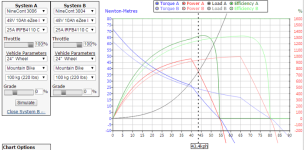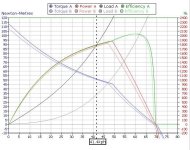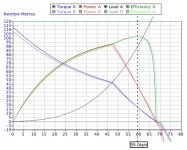
liveforphysics said:
Kiwifiat- You are still failing to get it, perhaps at all levels. This seems astounding, as I don't believe you or Kingfish are incompetent to understand.
I^2*R loss is the copper loss component. If the same amount of copper is around the tooth, it makes the same amount of continuous torque, and continuous power, and the same heat production per amount of torque etc. Likewise, it would be no additional power consumption from a battery to make that same amount of torque/power etc.
A motors resistance climbs at the SQUARE of the number of turns, yet the current demand to make a given amount of torque varies inversely proportional, yet this linear decrease in current decreases heating by the ROOT of current. This makes them cancel each other cleanly, and is why a 1t motor makes torque exactly as efficiently as a 10t motor, despite one needing 10x higher drive current (at 1/10th the average bucked-down phase voltage, so power drawn from the pack is identical).
I was going to break it all down again for you in a long response, but I don't think it needs to be made clearer than the examples already provided in this thread, it just needs them to be read and understood rather than read and replaced by pre-existing confused delusions of knowing.
Liveforphysics I wonder if you even read and comprehend what others are saying. Above I wrote:
Kiwifiat said:
Niether Kingfish or I are debating the fact that copper losses between equal fill winding options are equal, the proof is trivial..
Can I make it any clearer?
You are whipping a dead horse on this point, there is no debate. I learnt that fact 32 years ago. Equally we can see that 10x1 = 1x10 , no debate and nothing insightful stating the bleeding obvious. What is obvious is that you have formed the opinion that you can drive however much current into a motor at any speed in order to convince yourself that turn count is irrelevant. Of course some of us have been taught that the amount of current that can be usefully driven into a motor is governed by the laws of physics as we know them.
We all know that the higher the turn count has a lower maximum rpm. We all know that we can convert Kv to Ke and that if we use SI units we also get Kt. So we can see that a higher turn count motor produces more torque per amp than a low turn count motor. We know that peak power is around 50% of the maximum no load speed and since the motors have different winds it follows that peak power occurs at different speeds. And since the power curves are different the torque curves must also be different. And if the power curves and the torque curves are different then the performance in a vehicle all else being equal will also be different. And we can see this without the use of a dyno, it is no more than the Laws of Physics tell us.
Attached above is a comparison from ebikes.ca of two more or less equal fill motors with the same constrained power source and controller fitted into the same diameter wheel.
What can we see? Well it seems that the higher turn count motor produces more torque all the way up to 40 Km/h, now I know you told me it is myth and BS but in my world more torque gives more tractive force at the wheel and according to Newtons Second Law of Motion that means better acceleration.
And as already stated by myself and others the higher turn count motor has a lower top speed, and as stated already the lower turn count motor has a higher top speed. And we can also see that both motors produce more or less the same power. Doesn't seem like the same real world performance does it.
And no surprise in my mind as that is exactly what the laws of physics predict.
liveforphysics said:
it just needs them to be read and understood rather than read and replaced by pre-existing confused delusions of knowing.
liveforphysics, you can belittle those with opinions that don't agree with your own. I was taught,verified in a laboratory, and examined on what I know about the subject at hand. There are no confused delusions in my mind.
I have read widely on the subject of motor design and I can not find a single reference to your opinion that a three phase motor inverter is a buck converter which seems to be the mysterious magic you bandy about whilst attempting to prove your point of view. So I ask again give us a reference to an IEEE paper or a PHD thesis to support your theory that you can drive any amount of current into a motor at any speed with a 1000V volt 10A inverter such that all motors regardless of inductance and resistance become equal. Until then we will just have to agree to disagree, but as James Mevey notes in his awesome thesis there is a lot of disagreement on the subject so we are in good company.






